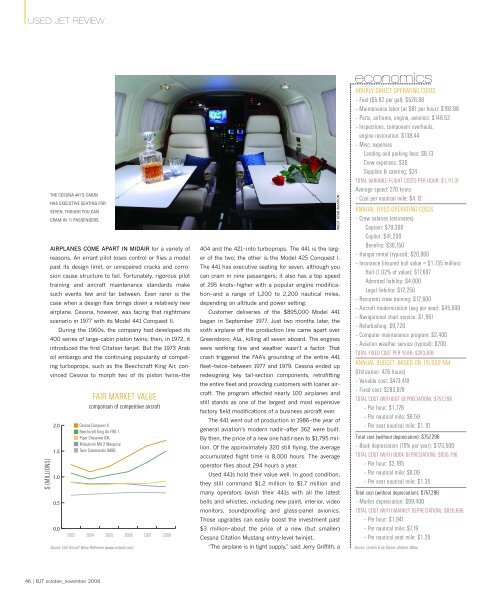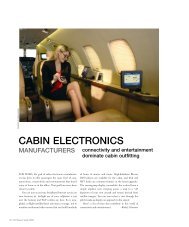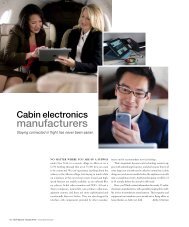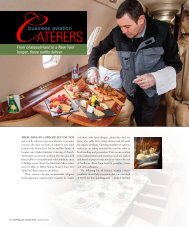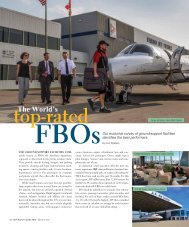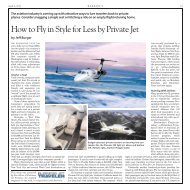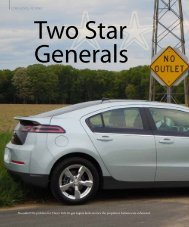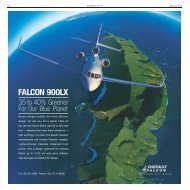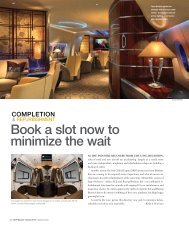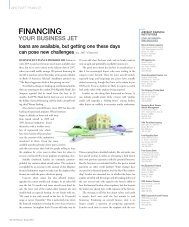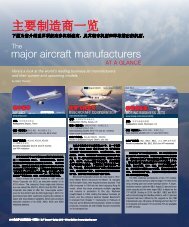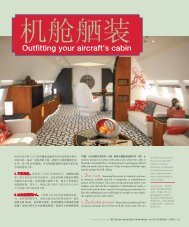CONQUEST II - Business Jet Traveler
CONQUEST II - Business Jet Traveler
CONQUEST II - Business Jet Traveler
Create successful ePaper yourself
Turn your PDF publications into a flip-book with our unique Google optimized e-Paper software.
USED JET REVIEW<br />
$ (MILLIONS)<br />
THE CESSNA 441’S CABIN<br />
HAS EXECUTIVE SEATING FOR<br />
SEVEN, THOUGH YOU CAN<br />
CRAM IN 11 PASSENGERS.<br />
AIRPLANES COME APART IN MIDAIR for a variety of<br />
reasons. An errant pilot loses control or flies a model<br />
past its design limit, or unrepaired cracks and corrosion<br />
cause structure to fail. Fortunately, rigorous pilot<br />
training and aircraft maintenance standards make<br />
such events few and far between. Even rarer is the<br />
case when a design flaw brings down a relatively new<br />
airplane. Cessna, however, was facing that nightmare<br />
scenario in 1977 with its Model 441 Conquest <strong>II</strong>.<br />
During the 1960s, the company had developed its<br />
400 series of large-cabin piston twins; then, in 1972, it<br />
introduced the first Citation fanjet. But the 1973 Arab<br />
oil embargo and the continuing popularity of competing<br />
turboprops, such as the Beechcraft King Air, convinced<br />
Cessna to morph two of its piston twins–the<br />
2.0<br />
1.5<br />
1.0<br />
0.5<br />
0.0<br />
2003<br />
FAIR MARKET VALUE<br />
comparison of competitive aircraft<br />
Cessna Conquest <strong>II</strong><br />
Beechcraft King Air F90-1<br />
Piper Cheyenne <strong>II</strong>XL<br />
Mitsubishi MU-2 Marquise<br />
Twin Commander 690B<br />
2004<br />
2005<br />
BJT/Illustrator/802e_usedjetpreview_FMV_AugSept08.eps<br />
46 I BJT october_november 2008<br />
2006<br />
Source: Vref Aircraft Value Reference (www.vrefpub.com)<br />
2007<br />
2008<br />
404 and the 421–into turboprops. The 441 is the larger<br />
of the two; the other is the Model 425 Conquest I.<br />
The 441 has executive seating for seven, although you<br />
can cram in nine passengers; it also has a top speed<br />
of 295 knots–higher with a popular engine modification–and<br />
a range of 1,200 to 2,200 nautical miles,<br />
depending on altitude and power setting.<br />
Customer deliveries of the $895,000 Model 441<br />
began in September 1977. Just two months later, the<br />
sixth airplane off the production line came apart over<br />
Greensboro, Ala., killing all seven aboard. The engines<br />
were working fine and weather wasn’t a factor. That<br />
crash triggered the FAA’s grounding of the entire 441<br />
fleet–twice–between 1977 and 1979. Cessna ended up<br />
redesigning key tail-section components, retrofitting<br />
the entire fleet and providing customers with loaner aircraft.<br />
The program affected nearly 100 airplanes and<br />
still stands as one of the largest and most expensive<br />
factory field modifications of a business aircraft ever.<br />
The 441 went out of production in 1986–the year of<br />
general aviation’s modern nadir–after 362 were built.<br />
By then, the price of a new one had risen to $1.795 million.<br />
Of the approximately 320 still flying, the average<br />
accumulated flight time is 8,000 hours. The average<br />
operator flies about 294 hours a year.<br />
Used 441s hold their value well. In good condition,<br />
they still command $1.2 million to $1.7 million and<br />
many operators lavish their 441s with all the latest<br />
bells and whistles, including new paint, interior, video<br />
monitors, soundproofing and glass-panel avionics.<br />
Those upgrades can easily boost the investment past<br />
$3 million–about the price of a new (but smaller)<br />
Cessna Citation Mustang entry-level twinjet.<br />
“The airplane is in tight supply,” said Jerry Griffith, a<br />
WEST STAR AVIATION<br />
economics<br />
HOURLY DIRECT OPERATING COSTS<br />
– Fuel ($5.92 per gal): $526.88<br />
– Maintenance labor (at $81 per hour): $192.88<br />
– Parts, airframe, engine, avionics: $146.52<br />
– Inspections, component overhauls,<br />
engine restoration: $138.44<br />
– Misc. expenses<br />
Landing and parking fees: $8.13<br />
Crew expenses: $30<br />
Supplies & catering: $24<br />
TOTAL VARIABLE FLIGHT COSTS PER HOUR: $1,111.31<br />
Average speed: 270 knots<br />
– Cost per nautical mile: $4.12<br />
ANNUAL FIXED OPERATING COSTS<br />
– Crew salaries (estimates)<br />
Captain: $79,300<br />
Copilot: $41,200<br />
Benefits: $36,150<br />
– Hangar rental (typical): $20,900<br />
– Insurance (insured hull value = $1.735 million)<br />
Hull (1.02% of value): $17,697<br />
Admitted liability: $4,000<br />
Legal liability: $12,250<br />
– Recurrent crew training: $12,600<br />
– Aircraft modernization (avg per year): $45,000<br />
– Navigational chart service: $1,961<br />
– Refurbishing: $9,720<br />
– Computer maintenance program: $2,400<br />
– Aviation weather service (typical): $700<br />
TOTAL FIXED COST PER YEAR: $283,878<br />
ANNUAL BUDGET–BASED ON 115,000 NM<br />
(Utilization: 426 hours)<br />
– Variable cost: $473,418<br />
– Fixed cost: $283,878<br />
TOTAL COST (WITHOUT DEPRECIATION): $757,296<br />
– Per hour: $1,778<br />
– Per nautical mile: $6.59<br />
– Per seat nautical mile: $1.10<br />
Total cost (without depreciation): $757,296<br />
– Book depreciation (10% per year): $173,500<br />
TOTAL COST (WITH BOOK DEPRECIATION): $930,796<br />
– Per hour: $2,185<br />
– Per nautical mile: $8.09<br />
– Per seat nautical mile: $1.35<br />
Total cost (without depreciation): $757,296<br />
– Market depreciation: $69,400<br />
TOTAL COST (WITH MARKET DEPRECIATION): $826,696<br />
– Per hour: $1,941<br />
– Per nautical mile: $7.19<br />
– Per nautical seat mile: $1.20<br />
Source: Conklin & de Decker, Orleans, Mass.


